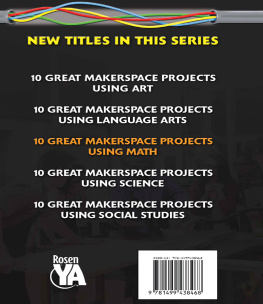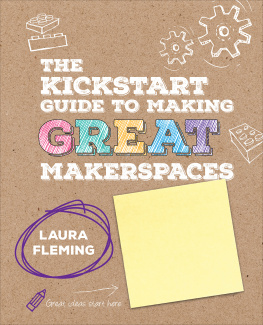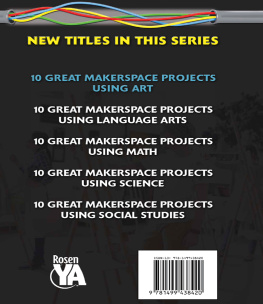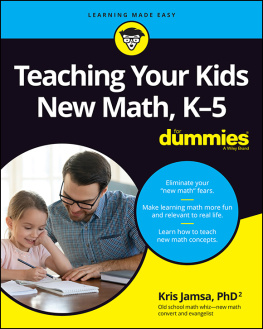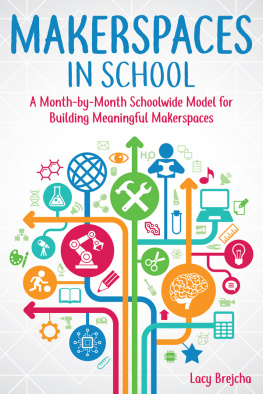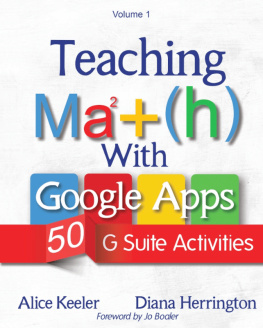Published in 2018 by The Rosen Publishing Group, Inc.
29 East 21st Street, New York, NY 10010
Copyright 2018 by The Rosen Publishing Group, Inc.
All rights reserved. No part of this book may be reproduced in any form without permission in writing from the publisher, except by a reviewer.
Names: Hall, Kevin, 1990 author.
Title: 10 great makerspace projects using math / Kevin Hall.
Description: First edition. | New York, NY: Rosen Publishing, 2018. | Series: Using makerspaces for school projects | Audience: Grades 6 to 12. | Includes bibliographical references and index.
Subjects: LCSH: MathematicsStudy and teaching. | MakerspacesJuvenile literature. | Science projectsJuvenile literature.
Makerspaces allow you to create fun, interactive projects that use a wide range of tools. They can be used for any subject and stress creativity and teamwork.
E ducators have always used special tools and projects in the classroom. In our society today, technology has made it easier for teachers to have projects in the classroom that help their students develop and learn. One of these developments is the idea of makerspaces. Makerspaces, also known to some as hackspaces or hackerspaces, have become extremely useful tools in the classroom.
Makerspace projects are totally up to the teachers, students, and schools. They are creative, hands-on activities that allow you to collaborate with others to invent, develop, and learn about a specific topic. Given this definition, it is interesting to see how makerspaces are developed in the classroom.
The focus of a makerspace project is up to the educator and student. Whether you use robots, programming, or some other form of electronics, it is important to look back on the definition of a makerspace. It is a community tool used for educational reasons. Here you will find ten projects that students can use in order to learn about various math concepts. Theres a whole world of makerspaces out there.
Makerspace projects also produce far-ranging effects outside of the classroom. It is true that the makerspace projects are used to educate students about a new topic. This may involve the use of simple tools or advanced ones such as 3D printers and lasers. Whatever the nature of the tools, it is important to note that you also have the chance to learn new social skills. Working together in a makerspace environment helps young people try out new aspects of social interaction as well.
Makerspace projects allow you to take risks and experiment using your own ideas. They allow you to realize that your ideas are valid in your own learning. The hands-on or do-it-yourself approach to learning allows readers to realize that their opinions and questions actually matter. The projects listed are meant to both teach and inspire students and educators alike.
Each of these projects includes some form of math concept. From basic math to more advanced concepts, youll be able to dive into creating, learning, and experimenting all at once. Makerspace math projects are not just fun but also educational. They serve a dual purpose in the classroom, allowing students to both engage in learning and fun, useful activities.
Makerspace projects stress the idea that learning can be an enriching experience inside the classroom. They allow participants to collaborate while flexing their creative muscles. Math concepts remain central to each project. Those who tackle math makerspaces will find themselves challenged to explore new ideas while working with new materials and technology.
CHAPTER ONE
THE MAKER MOVEMENT
M akerspaces have popped up in schools, libraries, and community centers all across the country. These spaces offer interactive and engaging tools to let you create as you learn. In fact, makerspaces have become so popular today that there is a new term for the craze around them: the maker movement.
Makerspaces, and the maker movement in general, have totally changed classroom projects. The goal of makerspaces and the maker movement is to allow you more freedom in your learning. Makerspaces arent going to totally replace textbooks, outlines, and book reports. They are, however, an unusual approach toward learning in the classroom. Still, makerspaces are much more than classrooms. There are many ways in which makerspaces have a positive effect on the students who engage with them.
For one, makerspace projects offer a new approach to learning. Instead of absorbing facts and figures, makerspaces allow students to instead experiment with new materials and ideas. Makerspace projects value curiosity. They give you a resource to experiment as well as learn in the classroom.
Each member of a team involved in a makerspace project has a certain responsibility to help the team learn and finish the project.
These projects also stress the idea of teamwork. Many of these projects require participants to form groups and work together in order to accomplish the goal. This has long-term effects both inside and out of the classroom. The teamwork idea that all makerspace projects stress helps participants learn the value of working together in groups. It also makes clear the fact that everyone in a group must contribute in order to get a specific task done.
MAKER CULTURE
The so-called maker culture that has come about from the maker movement extends far beyond the classroom. The do-it-yourself attitude has reached into other jobs as well. Whether its a clothing designer sewing his or her own fabric to create new fashions, a musician creating a new band or sound using homemade instruments, or scientists inventing their own devices with original homemade designs, the maker movement has seen a fair share of development outside of the classroom. Maker Faires are events where creative minds can meet to showcase and discuss their own projects. While makerspace projects are great classroom tools, they also have an impact outside of the classroom.
The making of all these makerspace projects also gives a sense of power to the students themselves. A completed makerspace project is a unique way for a student to prove that he or she has learned something. Rather than doing well on a test or an assignment, a finished makerspace is a direct way of a student showing he or she has mastered a certain concept. The maker movement has inspired students and teachers to be excited about learning.

